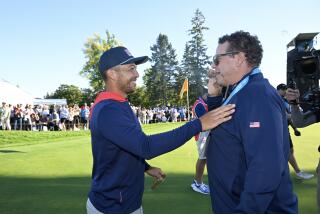After Two America’s Cup Races, It’s Technology 1, Sailing 1 : Yachting: The experts say Il Moro skipper Cayard is dealing well with America 3’s edge in speed.
- Share via
SAN DIEGO — The gravity of the situation, the experts had said, was that America 3 was faster, but that Paul Cayard would tilt the America’s Cup toward Italy, like the Leaning Tower of Pisa.
Well, the first two apples have fallen, and even Sir Isaac Newton would have to admit that the experts have been right--so far. Moving into today’s third race of the best-of-seven series, it’s tied, 1-1, with Cayard playing Wile E. Coyote to Bill Koch’s Roadrunner.
As suspected, America 3 has been fast--especially downwind in Sunday’s light wind--and the only reason America 3 isn’t 2-0 is the tenacity of Cayard and the Il Moro di Venezia crew--and, perhaps, the inclination of the on-water umpires to let the boys play a little rough.
On the other hand, America 3 might be 0-2 if the Italians--or, more specifically, the Americans in the back of the Italian boat--hadn’t given America 3 a 30-second head start by bungling the start of Race 1.
Sailing conservatively, America 3 was content to win by that same margin.
David Pedrick, who helped design Dennis Conner’s Stars & Stripes, said after the first two races, “So far, it looks as if ‘Cube’ (America 3) has an advantage upwind in 11 or 12 knots (of wind), but when it drops below 10 it may be Il Moro.
“Sunday (in light wind), there might have been a little edge to Il Moro upwind--but a big one to Cube downwind.”
Chris Dickson, skipper for the Nippon Challenge, said Monday, “It looks to me that America 3 has the good parts of Il Moro and New Zealand and Nippon rolled into one. That’s the advantage of being a later boat.”
Because of an imbalance in the rules, the challengers had to have their campaign boats ready for the start of their trials Jan. 24. The defender didn’t have to have his boat ready until last week. Theoretically, that gave Koch time to study what wrinkles worked best and build accordingly.
But he brought in America 3, his third of four boats, as the challenger trials were getting under way. It proved better than Kanza, the fourth boat, which arrived in March.
People who pay attention to such things noted that America 3 was distinctively narrower than the others, the better to negotiate the Point Loma chop and slop that is usually out of proportion to the wind. Koch said his scientists had that all figured out last year.
“America 3 was actually decided upon in August of last year, and we made it upon a different design concept than what the Italian boat is,” Koch said. “We have different beam (width) at the water line, different beam at the deck, different hull shape--although we are both, I think, at the heavy end of the (design parameters).”
But is speed enough? The pole-sitter usually doesn’t win the Indianapolis 500.
Pedrick said: “It looks like (USA) 23 (America 3), on boat speed, probably should win this America’s Cup. On sailing potential, Cayard.”
Cayard’s edge may be his style. He is more aggressive than America 3’s Buddy Melges, who has sailed few match races outside the last two America’s Cups.
Cayard surprised Melges at a critical point in Sunday’s race when he turned sharply upwind toward America 3--an aggressive tactical maneuver called a luff--to defend his lead against the faster boat.
In the defender finals, Conner surprised Melges with three quick luffs, also to defend a lead that he was able to hold to the finish.
If Cayard can continue to sail that aggressively--and indications are that he will--he has a chance.
There were four protests called Sunday, three by America 3--all green-flagged (ruled no foul) by the umpires. That means umpires are letting the ticky-tack fouls go and aren’t seeing other alleged fouls, or sailors are protesting just in hopes of getting a call. It’s probably a combination of all three.
Cayard’s only faulting of the umpires was for their not approving his protest against America 3 in the luffing incident.
“We were a little upset--and I looked right at the judges when they green-flagged the incident--because I did see the (America 3) spinnaker hit my backstay,” Cayard said.
On-water umpiring is new to this America’s Cup, and all competitors--with the possible exception of Conner--have agreed that, right or wrong, it’s a lot better doing a penalty turn worth three or four boat lengths than thrashing out disputes overnight in a protest room, then being disqualified.
“They’re doing the best job they can,” Cayard said. “And it’s not that easy.
“It’s not like referees running up and down a basketball court 20 feet away. You’re in a boat. You have to talk to the driver. You have to try to stay out of the way. You have to not block (the boats’) wind or put wake on them. I think they’re doing a good job.
“It’s always tough on anybody to have to decide the outcome of a race. Human nature would be that if it’s close and nothing severe, they’d rather not do that. I know all five of those guys personally. I can feel for them.”
Koch said, “On-the-course umpiring is fantastic. It does prevent your having to be a lawyer. God knows, there are 2 million in this world already.”
More to Read
Go beyond the scoreboard
Get the latest on L.A.'s teams in the daily Sports Report newsletter.
You may occasionally receive promotional content from the Los Angeles Times.










